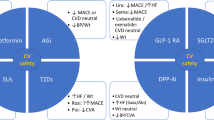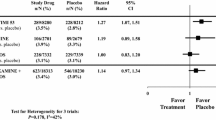Abstract
Purpose of Review
The purpose is to review evidence on cardiovascular risks and benefits of new treatments for type 2 diabetes mellitus.
Recent Findings
In response to guidance issued by the Food and Drug Administration, thousands of patients have been enrolled in large randomized trials evaluating the cardiovascular effects of the three newest diabetes drug classes: glucagon-like peptide-1 (GLP-1) receptor agonists, sodium glucose cotransporter 2 (SGLT-2) inhibitors, and dipeptidyl peptidase-4 (DPP-4) inhibitors. Two studies of GLP-1 receptor agonists—one of liraglutide and one of semaglutide—have shown cardiovascular benefit relative to placebo, and one study of the SGLT-2 inhibitor empagliflozin has shown benefit. The other published cardiovascular outcome studies of the newest drug classes have generally supported safety, apart from an as-yet unresolved safety concern about increased rates of heart failure with DPP-4 inhibitors. Recent research suggests the thiazolidinedione pioglitazone may have beneficial effects on some cardiovascular outcomes as well, but these are counterbalanced by a known increase of the risk of heart failure with this drug. In general, more prospective randomized trial data is now available regarding the cardiovascular effects of the newer diabetes drugs than on the older drug classes.
Summary
New evidence suggests that the newest diabetes drugs are safe from a cardiovascular perspective. Evidence on benefit from at least some members of the GLP-1 receptor agonist and SGLT-2 inhibitor classes is encouraging but not yet decisive.

Similar content being viewed by others
References
Papers of particular interest, published recently, have been highlighted as: •• Of major importance
Go A, Mozaffarian D, Roger V, et al. Executive summary: heart disease and stroke statistics—2013 update: a report from the American Heart Association. Circulation. 2013;127(1):143–52.
Standards of Medical Care in Diabetes—2016. Diabetes Care S52–S59.
Hiatt W, Kaul S, Smith R. The cardiovascular safety of diabetes drugs—insights from the rosiglitazone experience. N Engl J Med. 2013;369(14):1285–7.
Smith R, Goldfine A, Hiatt W. Evaluating the cardiovascular safety of new medications for type 2 diabetes: time to reassess? Diabetes Care. 2016;39(5):738–42.
Ingelfinger J, Rosen C. Cardiac and renovascular complications in type 2 diabetes—is there hope? N Engl J Med. 2016;375(4):380–2.
Lipska K, Krumholz H. Comparing diabetes medications: where do we set the bar? JAMA Intern Med. 2014;174(3):317–8.
Association AD. Approaches to glycemic treatment. Sec. 7. In: Standards of medical care in diabetes—2016. Diabetes Care 2016;39 Suppl. 1: S52–S59.
Intensive blood-glucose control with sulphonylureas or insulin compared with conventional treatment and risk of complications in patients with type 2 diabetes (UKPDS 33). UK Prospective Diabetes Study (UKPDS) Group. Lancet 1998;352(9131):837–53
Holman R, Paul S, Bethel M, Matthews D, Neil H. 10-year follow-up of intensive glucose control in type 2 diabetes. N Engl J Med. 2008;359(15):1577–89.
Hong J, Zhang Y, Lai S, et al. Effects of metformin versus glipizide on cardiovascular outcomes in patients with type 2 diabetes and coronary artery disease. Diabetes Care. 2013;36(5):1304–11.
Hampp C, Borders-Hemphill V, Moeny D, Wysowski D. Use of antidiabetic drugs in the U.S., 2003–2012. Diabetes Care. 2014;37(5):1367–74.
Nathan D. Diabetes: advances in diagnosis and treatment. JAMA. 2015;314(10):1052–62.
Goldner M, Knatterud G, Prout T. Effects of hypoglycemic agents on vascular complications in patients with adult-onset diabetes. JAMA. 1971;218(9):1400–10.
Hong J, Zhang Y, Lai S, et al. Effects of metformin versus glipizide on cardiovascular outcomes in patients with type 2 diabetes and coronary artery disease. Diabetes Care. 2013;36(5):1304–11.
Monami M, Genovese S, Mannucci E. Cardiovascular safety of sulfonylureas: a meta-analysis of randomized clinical trials. Diabetes Obes Metab. 2013;15(10):938–53.
Phung O, Schwartzman E, Allen R, Engel S, Rajpathak S. Sulfonylureas and risk of cardiovascular disease: systematic review and meta-analysis. Diabet Med. 2013;30(10):1160–71.
Ou S, Shih C, Chao P, et al. Effects on clinical outcomes of adding dipeptidyl peptidase-4 inhibitors versus sulfonylureas to metformin therapy in patients with type 2 diabetes mellitus. Ann Intern Med. 2015;163(9):663–72.
Morgan C, Mukherjee J, Jenkins-Jones S, Holden S, Currie C. Combination therapy with metformin plus sulfonylureas versus metformin plus DPP-4 inhibitors: association with major adverse cardiovascular events and all-cause mortality. Diabetes Obes Metab. 2014;16(10):977–83.
Cryer P. Mechanisms of hypoglycemia-associated autonomic failure in diabetes. N Engl J Med. 2013;369(4):362–72.
Wright R, Frier B. Vascular disease and diabetes: is hypoglycemia an aggravating factor? Diabetes Metab Res Rev. 2008;24(5):353–63.
Desouza C, Bolli G, Fonesca V. Hypoglycemia, diabetes, and cardiovascular events. Diabetes Care. 2010;33(6):1389–94.
Ashcroft F, Gribble F. Tissue-specific effects of sulfonylureas: lessons from studies of cloned K(ATP) channels. J Diabetes Complicat. 2000;14(4):192–6.
Zunkler B. Human ether-a-go-go-related (HERG) gene and ATP-sensitive potassium channels as targets for adverse drug effects. Pharmacol Ther. 2006;112(1):12–37.
Hattersley A, Thorens B. Type 2 diabetes, SGLT2 inhibitors, and glucose secretion. N Engl J Med. 2015;373:974–97.
Brunton S. The potential role of sodium glucose co-transporter 2 inhibitors in the early treatment of type 2 diabetes mellitus. Int J Clin Pract. 2015;69(10):1071–87.
Inzucchi S, Zinman B, Wanner C, et al. SGLT-2 inhibitors and cardiovascular risk: proposed pathways and review of ongoing outcome trials. Diab Vasc Dis Res. 2015;12(2):90–100.
Ceriello A, Genovese S, Mannucci E, Gronda E. Understanding EMPA-REG OUTCOME. Lancet Diabetes Endocrinol. 2015;3(12):929–30.
Mudaliar S, Alloju S, Henry R. Can a shift in fuel energetics explain the beneficial cardiorenal outcomes in the EMPA-REG OUTCOME study? A unifying hypothesis. Diabetes Care. 2016;39(7):1115–22.
Vasilakou D, Karagiannis T, Athanasiadou E, et al. Sodium-glucose cotransporter 2 inhibitors for type 2 diabetes: a systematic review and meta-analysis. Ann Intern Med. 2013;159(4):262–74.
•• Zinman B, Wanner C, Lachin J, et al. Empagliflozin, cardiovascular outcomes, and mortality in type 2 diabetes. N Engl J Med. 2015;373(22):2117–28. Recent cardiovascular outcome study showing evidence of cardiovascular benefit from a new antidiabetic drug.
Perseghin G, Solini A. The EMPA-REG outcome study: critical appraisal and potential clinical implications. Cardiovascular Diabetol 2016;15(85).
Neumiller J. Incretin-based therapies. Med Clin N Am. 2015;99(1):107–29.
Vergès B, Bonnard C, Renard E. Beyond glucose lowering: glucagon-like peptide-1 receptor agonists, body weight and the cardiovascular system. Diabetes Metab. 2011;37(6):477–88.
Poornima I, Brown S, Bhashyam S, Parikh P, Bolukoglu H, Shannon R. Chronic glucagon-like peptide-1 infusion sustains left ventricular systolic function and prolongs survival in the spontaneously hypertensive, heart failure-prone rat. Circ Heart Fail. 2008;1(3):153–60.
Treiman M, Elvekjaer M, Engstrøm T, Jensen J. Glucagon-like peptide 1—a cardiologic dimension. Trends Cardiovasc Med. 2010;20(1):8–12.
Sokos G, Nikolaidis L, Mankad S, Elahi D, Shannon R. Glucagon-like peptide-1 infusion improves left ventricular ejection fraction and functional status in patients with chronic heart failure. J Card Fail. 2006;12(9):694–9.
•• Marso S, Daniels G, Brown-Frandsen K, et al. Liraglutide and cardiovascular outcomes in type 2 diabetes. N Engl J Med. 2016;375(4):311–22. Recent cardiovascular outcome study showing evidence of cardiovascular benefit from a new antidiabetic drug.
•• Marso SP, Bain SC, Consoli A, et al. Semaglutide and cardiovascular outcomes in patients with type 2 diabetes. N Engl J Med. 2016. Recent cardiovascular outcome study showing evidence of cardiovascular benefit from a new antidiabetic drug.
Pfeffer M, Claggett B, Diaz R, et al. Lixisenatide in patients with type 2 diabetes and acute coronary syndrome. N Engl J Med. 2015;373(23):2247–57.
Ban K, Noyan-Ashraf M, Hoefer J, Bolz S, Drucker D, Husain M. Cardioprotective and vasodilatory actions of glucagon-like peptide 1 receptor are mediated through both glucagon-like peptide 1 receptor-dependent and -independent pathways. Circulation. 2008;117(18):2340–50.
White W, Cannon C, Heller S, et al. Alogliptin after acute coronary syndrome in patients with type 2 diabetes. N Engl J Med. 2013;369(14):1327–35.
Green J, Bethel M, Armstrong P, et al. Effect of sitagliptin on cardiovascular outcomes in type 2 diabetes. N Engl J Med. 2015;373(3):232–42.
Scirica B, Bhatt D, Braunwald E, et al. Saxagliptin and cardiovascular outcomes in patients with type 2 diabetes mellitus. N Engl J Med. 2013;369(14):1317–26.
Maruther N, Tseng E, Hutfless S, et al. Diabetes medications as monotherapy or metformin-based combination therapy for type 2 diabetes: a systematic review and meta-analysis. Ann Intern Med. 2016;164(11):740–51.
Gilbert R, Krum H. Heart failure in diabetes: effects of anti-hyperglycaemic drug therapy. Lancet. 2015;385(9982):2107–17.
Filion K, Azoulay L, Platt R, et al. A multicenter observational study of incretin-based drugs and heart failure. N Engl J Med. 2016;374(12):1145–54.
Morgan C, Mukherjee J, Jenkins-Jones S, Holden S, Currie C. Combination therapy with metformin plus sulphonylureas versus metformin plus DPP-4 inhibitors: association with major adverse cardiovascular events and all-cause mortality. Diabetes Obes Metab. 2014;16(10):977–83.
Kahn C, Chen L, Cohen S. Unraveling the mechanism of action thiazolidinediones. J Clin Invest. 2000;106(11):1305–7.
Nissen S, Wolski K. Effect of rosiglitazone on the risk of myocardial infarction and death from cardiovascular causes. N Engl J Med. 2007;356(24):2457–71.
Home P, Pocock S, Beck-Nielsen H, et al. Rosiglitazone evaluated for cardiovascular outcomes in oral agent combination therapy for type 2 diabetes (RECORD): a multicentre, randomised, open-label trial. Lancet. 2009;373(9681):2125–35.
Psaty B, Furberg C. The record on rosiglitazone and the risk of myocardial infarction. N Engl J Med. 2007;357(1):67–9.
Psaty B, Prentice R. Variation in event rates in trials of patients with type 2 diabetes. JAMA. 2009;302(15):1698–700.
Dormandy J, Charbonnel B, Eckland D, et al. Secondary prevention of macrovascular events in patients with type 2 diabetes in the PROactive Study (PROspective pioglitAzone Clinical Trial In macroVascular Events): a randomized controlled trial. Lancet. 2005;366(9493):1279–89.
Erdmann E, Charbonnel B, Wilcox R, et al. Pioglitazone use and heart failure in patients with type 2 diabetes and preexisting cardiovascular disease: data from the PROactive study (PROactive 08). Diabetes Care. 2007;30(11):2773–8.
Kernan W, Viscoli C, Furie K, et al. Pioglitazone after ischemic stroke or transient ischemic attack. N Engl J Med. 2016;374(14):1321–31.
Tahrani A, Barnett A, Bailey C. Pharmacology and therapeutic implications of current drugs for type 2 diabetes mellitus. Nat Rev Endocrinol. 2016;12(10):566–92.
http://www.fda.gov/downloads/AdvisoryCommittees/CommitteesMeetingMaterials/Drugs/EndocrinologicandMetabolicDrugsAdvisoryCommittee/UCM510017.pdf. Accessed 10 June 2016.
Floyd J, Wiggins K, Sitlani C, et al. Case–control study of second-line therapies for type 2 diabetes in combination with metformin and the comparative risks of myocardial infarction and stroke. Diabetes Obes Metab. 2015;17(12):1194–7.
Author information
Authors and Affiliations
Corresponding author
Ethics declarations
Conflict of Interest
James H. Flory, Jenny K. Ukena, and James S. Floyd declare that they have no conflict of interest.
Human and Animal Rights and Informed Consent
This article does not contain any studies with human or animal subjects performed by any of the authors.
Additional information
This article is part of the Topical Collection on Clinical Trials and Their Interpretations
Rights and permissions
About this article
Cite this article
Flory, J.H., Ukena, J.K. & Floyd, J.S. Novel Anti-glycemic Drugs and Reduction of Cardiovascular Risk in Diabetes: Expectations Realized, Promises Unmet. Curr Atheroscler Rep 18, 79 (2016). https://doi.org/10.1007/s11883-016-0633-y
Published:
DOI: https://doi.org/10.1007/s11883-016-0633-y




